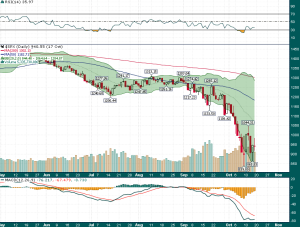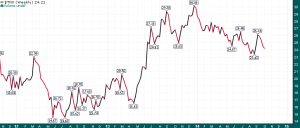While we can look back to the 2008 global financial market meltdown and cite any number of warning signs that became so painfully obvious in hindsight. Perhaps the clearest warning sign that trouble was just around the corner began in July of 2008 when virtually all commodities entered into a steep tailspin which they would not pull out of for at least another 8 months:
Click to enlarge
Platinum (top), WTI crude oil (center), and copper (bottom) offer a sampling of the steep downside reversals that commodities as a group suffered beginning in July 2008.
Perhaps what was most interesting about the commodities collapse of summer 2008 was the consistent commentary that the bullish thesis for commodities (China, BRICs, global growth, etc.) was still very much intact even as prices continued to tumble. As it turned out the commodities meltdown foreshadowed much deeper problems in the global financial system which would become exposed two months later:
S&P 500 (May - October 2008)
A similar phenomenon is currently taking place in global financial markets; a commodities collapse which began during the summer, immense strength in the US dollar, lower highs and multiple signs of fading health in the stock market:
While the magnitude of the current commodities sell-off pales in comparison to 2008, it is still relatively unusual to see all commodities decline in unison such as we are witnessing now. In fact the last two times this happened (2008 and 2011), equities followed suit and suffered large declines 2-3 months later. Could we be in for a 2008 redux? Or will this time be different for the stock market?
While only time will tell, we can certainly deduce that commodities are telling us that not all is well in terms of global economic growth. This assessment of slow growth and tame inflation levels is also confirmed by falling bond yields:
The 10-year Treasury Note yield is back near its lows for the year at 2.42% - a yield level that is not exactly symptomatic of strong economic growth or inflation concerns

























